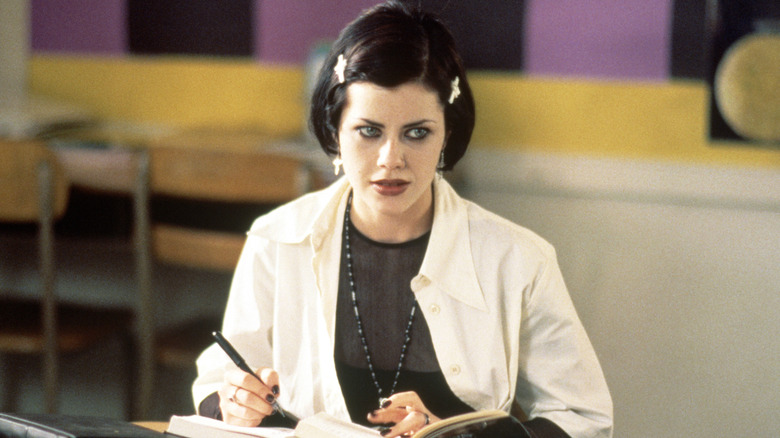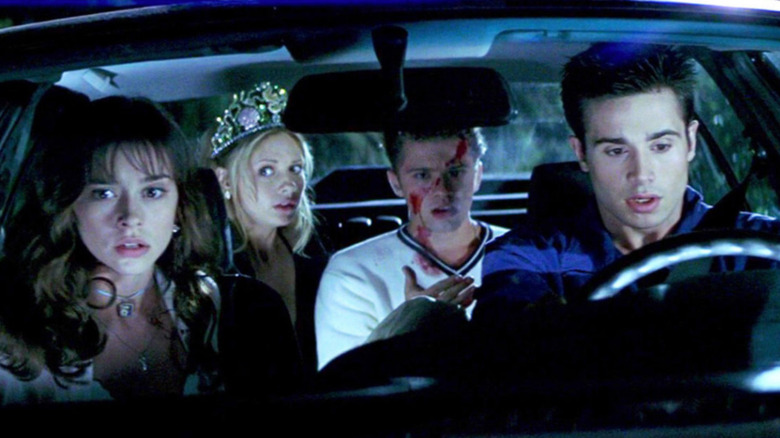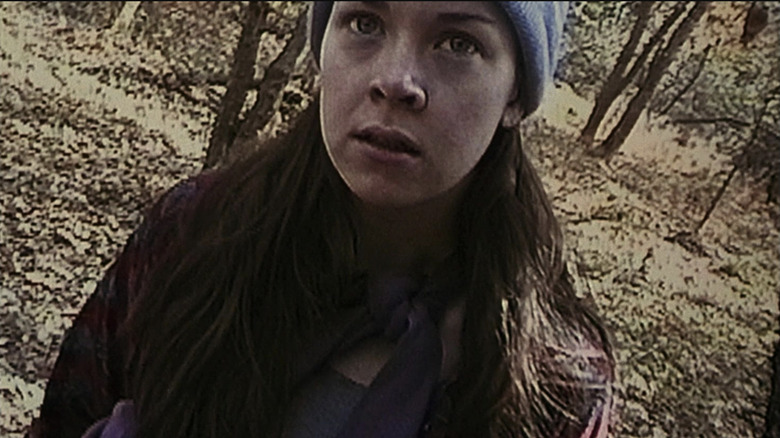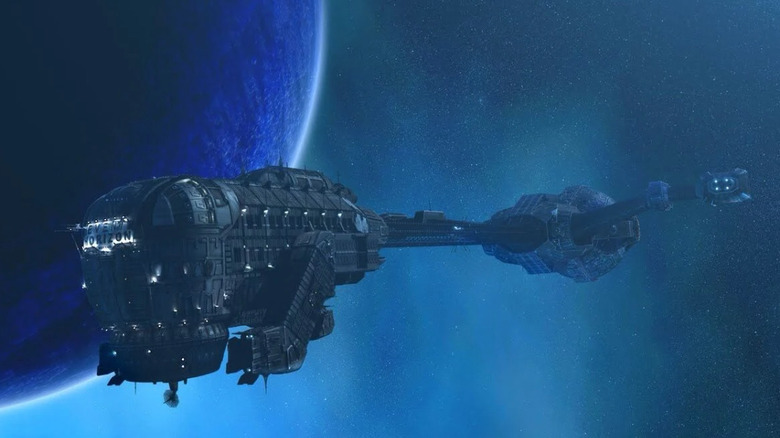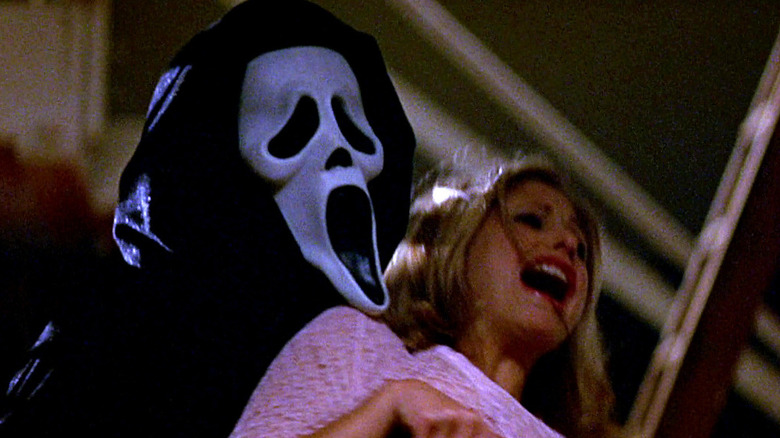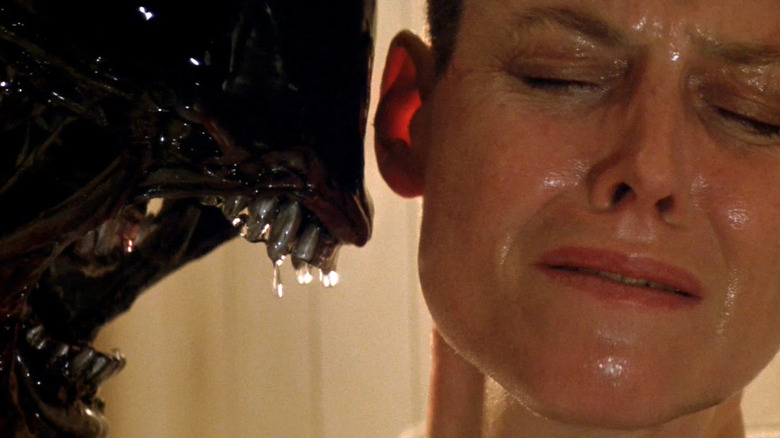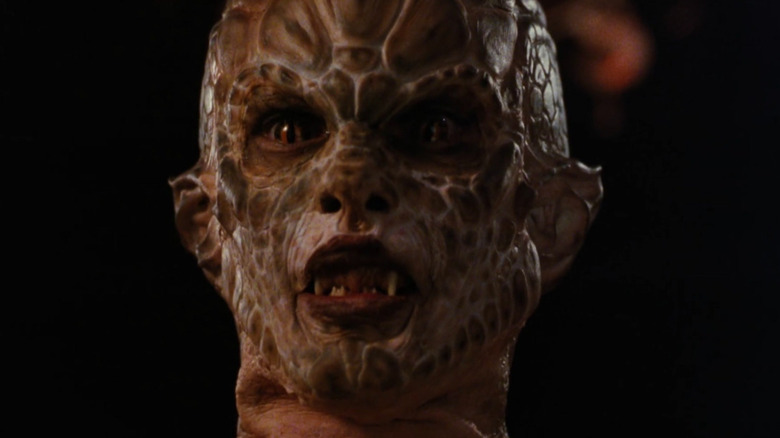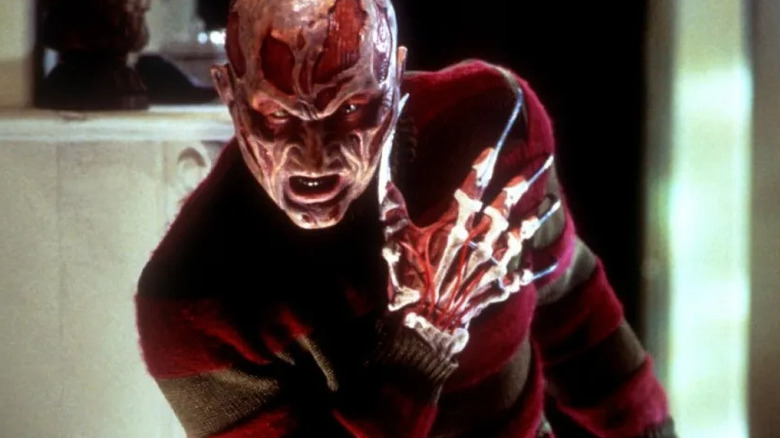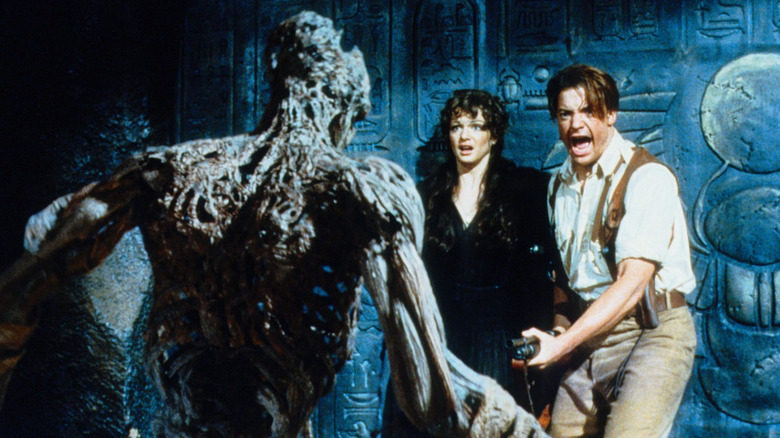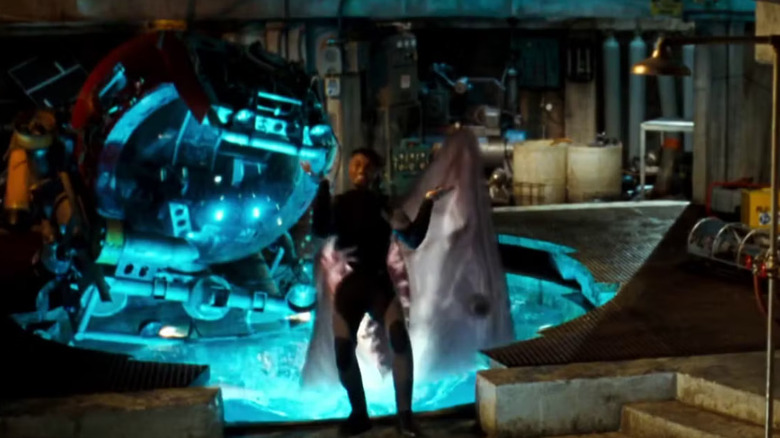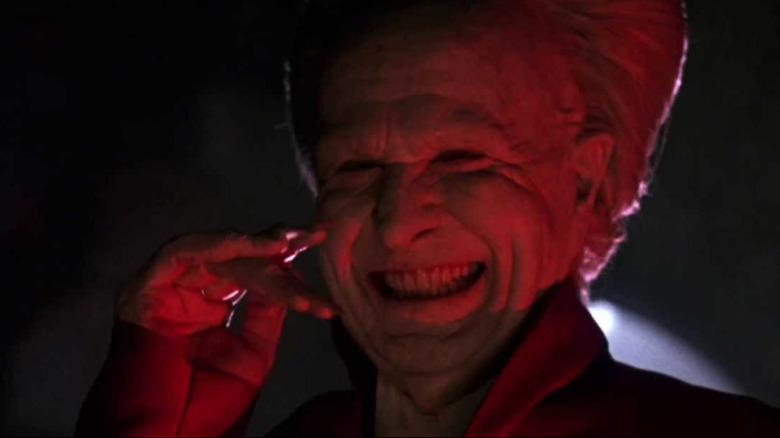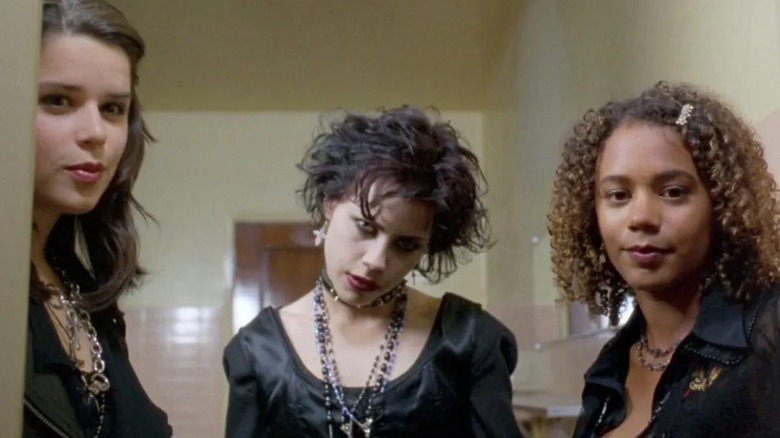The Most Overrated Horror Movies Of The '90s
"Scream." "Army of Darkness." "Jacob's Ladder." The 1990's were a prime time for the release of what have now become classic horror films. From clever deconstructions and invigorating sequels to visually-inspired — if grotesque — phantasmagorias, the decade before the millennium pushed the horror genre to new and gloriously devious heights. Heck, the film "Silence of the Lambs" even became the first horror film to win best picture in 1992! Not only that, but the '90s also introduced new horror mascots which became household names, such as Ghostface, Candyman, and the Tremors.
But despite the films that made the '90s a great decade for horror, there were — like in any decade — a lot of lifeless duds, useless retreads, and utter stinkers as well. Furthermore, there are also films that, for whatever reason, have gotten more kudos than they deserve in the intervening years. Not necessarily terrible horror films per se, but ones that have an out-sized legacy in comparison to their actual relative quality. These are horror movies that might have some memorable scenes, cool creature effects, or fun performances ... but are less than the sum of their parts, or are severely lacking in other areas that nostalgia has somehow made audiences turn a blind eye to. (There are also some outright terrible horror movies that have gotten unearned recognition as well.)
So, in that spirit, we have ranked the most overrated horror films from the 1990s. Do you agree with our list? Read on below to find out!
I Know What You Did Last Summer
Slasher films where teenagers are systematically and gorily killed have been a mainstay of the horror genre, arguably starting in earnest with films like 1974's "Black Christmas" and John Carpenter's 1978 classic "Halloween." However, the teen slasher genre reached a peak in the '80s, and while there was a bit of a downturn in their popularity starting in the '90s, they made a resurgence after the success of the deconstructionist "Scream" film.
One of the more successful of the many post-"Scream" teen slashers was 1997's "I Know What You Did Last Summer," which is getting a third film with returning cast members in 2025. Meanwhile, the original film (coincidentally written by "Scream" screenwriter Kevin Williamson) was loosely based on the 1973 novel of the same name, and follows a group of teens who — while drunk driving down a road at night — run over and seemingly kill a man. Afterward, the teens make a pact to not tell anyone about the accident. A year later, however, they start getting bloodily picked off one-by-one, with the titular warning that the killer knows what they did last summer.
While the killer is reportedly based on the urban legend of "The Hook," he's seen wearing a rain coat that makes him look like a fish sticks corporate mascot. Not exactly something that strikes much fear. The characters are also pretty unlikable, which makes the mostly lame killings even more unsatisfying. Still, "I Know What You Did Last Summer" is one of the better "Scream" knock-offs ... but that's not saying much.
The Blair Witch Project
"The Blair Witch Project" was a phenomenon when it was released back in 1999. It cost only $60,000, due to shooting with almost no crew and consumer-level cameras, while selling itself as a "found footage" film. At the time, many people fell for the film's masterful marketing (which included a complimentary "documentary" that aired on the SyFy Channel, purporting to be a true crime doc about the disappearance of the characters in the film). For some reason, people in the '90s believed that a major studio like Miramax would release what is essentially a snuff film. To be fair, things like early internet ARG sites with massive lore and hiding the actors' appearances until after the release of the film helped with this mystique.
The issue is, the film doesn't have much going for it outside its found footage gimmick. It's not even the first found footage film, preceded by films such as 1980's "Cannibal Holocaust" and 1998's "The Last Broadcast." The influence and popularization of "The Blair Witch Project" is similar to the computer game "Doom" and first-person shooters: Neither were the first of their kind, but they were the ones that put their respective genres on the map in a mainstream way.
So the film deserves some kudos for its relatively fun novelty, but the film itself is pretty boring, as nothing really happens. The actors do an adequate job displaying fear and agitation while trekking through the woods — but there's unfortunately not much else going on.
Event Horizon
The 1997 psychological sci-fi/horror film "Event Horizon" was director Paul W.S. Anderson's follow-up to his amazing 1995 "Mortal Kombat" live-action adaptation. While Anderson was forced by the studio to make "Mortal Kombat" PG-13, he went full ham with the newly minted freedom the R-rating "Event Horizon" granted him. In fact, the untold truth of "Event Horizon" is that there are minutes of disturbing footage that is currently lost, despite attempts to add it in an extended director's cut.
The film itself is about a curiously crucifix-shaped ship, called the Event Horizon, which was deemed lost after using an experimental form of gravity drive. However, the ship has since returned around Neptune (chosen, presumably, because it allowed Anderson to film the spooky Event Horizon floating around what look like roaring thunderclouds in space). A working-class crew led by Captain Miller (Lawrence Fishburne), is called in to investigate, bringing in the inventor of the gravity drive, Dr. William Weir (Sam Neill), to help with the investigation.
For the most part the visuals and production design are pretty stellar (if a bit derivative of other sci-fi horror films, like the original "Alien"). Unfortunately, there are also a lot of cheesy moments, including some bafflingly dumb, cliché horror movie character decisions that ultimately undermine the dark atmosphere Anderson is trying to evoke. The most galling is a character being shot out into space, and then comically floating back spouting one-liners to save the day. Ugh.
Scream 2
The first "Scream," released in 1996 and directed by Wes Craven, is a bona fide horror classic. Not only is Kevin Williamson's script a clever deconstruction of slasher films, metatextually using the genre's well-worn tropes against the audience (such as subverting the "only virgins survive" cliché), but it's a tense and terrifying horror film in its own right as well.
As far as quality goes, the "Scream" franchise is one of the most relatively consistent, both critically and financially. In fact, many have even declared its sequels, including "Scream 2," to be superior films. We disagree, of course. This is not to say "Scream 2" is a bad film or a bad sequel — far from it. In fact, we'll even concede it's one of the best horror sequels ever. "Scream" was just that good.
When compared to most of the other films in the "Scream" series, the ending doesn't make a lot of sense, since the killers from "Scream 2" are revealed to be Billy Loomis's mom (Laurie Metcalf) and a random movie buff who's only in a few scenes prior (a young Timothy Olyphant), without much foreshadowing. This is because "Scream 2" became one of the first victims of an online script leak, forcing the writers to scrap their original ending and come up with new killers on the fly. Unfortunately, it shows.
Alien 3
David Fincher is a household name now, and often considered to be one of the greatest American filmmakers. However, in the early '90s, Fincher was mainly known for directing music videos, and "Alien 3" was his feature film directorial debut. Unfortunately, development was already behind schedule by the time Fincher was brought on board, and the script was unfinished, making the shoot of "Alien 3" a disaster behind-the-scenes. It's also arguably the most controversial of the sequels, as it's very nihilistic and nasty for nasty's sake, with the death of Newt (Carrie Henn) and Corporal Dwayne Hicks (Michael Biehn) during the opening titles feeling unearned and unnecessary.
While "Alien 3" wasn't necessarily critically well-received at the time, there's been a sort-of critical reappraisal, which is frankly unearned. For one, besides the previously-mentioned off-screen death of beloved characters, the film goes from multiple aliens — like in "Aliens" — back to just one, which is a step back. Also, it's set on a desolate, gray prison planet where everyone is bald, including Ellen Ripley (star Sigourney Weaver). So the settings are boring and samey, just like the characters. Worse, there were so many better concepts floating around, such as a teaser trailer where it implied the xenomorphs would be terrorizing Earth (which wouldn't happen for real until 2025 with the upcoming "Alien: Earth" show), and a version where space monks fought the aliens on a planet made of wood. Besides some decent kills and an admittedly thematically resonant ending, there's not much to recommend.
From Dusk Till Dawn
Iconic genre filmmakers Quentin Tarantino and Robert Rodriguez uniting to work on a project together: What could go wrong? The 1996 action crime horror comedy "From Dusk Till Dawn," apparently. The film, directed by Rodriguez, was a star-making turn for George Clooney, who up until then was mainly known as a television star (it was released a year before he donned the cape and cowl for "Batman and Robin"). Clooney plays criminal Seth Gecko, the more cool-headed brother of fellow criminal Richie Gecko (writer Quentin Tarantino), introduced in the film violently robbing a store. They then kidnap a family vacationing in an RV, whose patriarch is a single dad (Harvey Keitel) and former priest who lost his faith after the death of his wife. The Gecko brothers force the kidnapped family to drive them to a bar in Mexico, which turns out to be infested with vampires.
The main issue with the film is the egregious and badly executed tonal dissonance. The beginning of "From Dusk Till Dawn" is tense and grounded, with even some emotional heft to the brother dynamic, as Clooney's Seth has to contend and navigate his love for Tarantino's Richie with Richie's psychopathic behavior. But the vampire stuff in the second half is overly campy and goofy, especially when compared to the crime thriller that came before. At one point, the band at the bar, Tito & Tarantula, plays instruments made out of human body parts when they're revealed to be vampires, like a dark "Looney Tunes" gag. And the less we say about the cheesy mid-'90s morphing effects, the better.
Wes Craven's New Nightmare
Wes Craven is definitely on the Mount Rushmore of all-time great horror directors, alongside such luminaries as Alfred Hitchcock, James Whale, and John Carpenter. This is because Craven has many classic horror films in his impressive oeuvre, including the "Scream" series, "The Last House on the Left," and, of course, "A Nightmare on Elm Street." Unfortunately, due to contractual issues, Craven didn't retain the rights to the franchise at the time, so he didn't direct any of the direct "Nightmare" sequels. That is, until "Wes Craven's New Nightmare" in 1994.
The idea is actually genius, which is why it's one of the highest-rated of the "Nightmare on Elm Street" sequels. It's a metatextual take on the franchise, where the main character is the actress Heather Langenkamp — who played Nancy in the original film — playing herself, dealing with a manifestation of Freddy Krueger who has escaped into the real world. Both Robert Englund, who played Freddy in all the canonical films and Wes Craven also play themselves, who think Heather is going crazy.
It's a really fun, unique idea, with some truly unsettling scenes, such as Freddy sticking his tongue through the phone. The issue with the film is some lack of follow-through, however. For instance, there's not much of a death count or gore. The real Freddy doesn't even kill Englund or Craven! Not a bad film by any stretch, but could've been better.
The Mummy
Sorry millennials, we know we're going to get a lot of hate for this one, but come on. 1999's "The Mummy" is just a really goofy and cheesy movie, with nary a scare to be found. Now, to be fair, scares aren't really what's on this film's mind, as it's much more of a rip-off "Indiana Jones" adventure film, set a decade or so earlier in 1926. But, to be less fair, it doesn't even necessary pull off that tone well, either.
The film follows spunky librarian and aspiring archaeologist Evelyn Carnahan (Rachael Weitz), as she teams up with the ne'er-do-well former Legionaire Rick O'Connell (an admittedly charismatic Brendan Fraser) to find a mythical Egyptian city. Unfortunately, they have to contend with the evil undead — and badly CGI'd –- titular mummy, Imhotep (Arnold Vosloo). However, even though Imhotep has the power to rain down the seven deadly plagues on 1920s Egypt, the fact that his kryptonite is literally a cat takes a lot of his menace away.
The leads give fun performances, and have great chemistry together. There are also some interesting visuals as well, such as the iconic face of sand (well, in theory, as most of the dated CGI effects don't really hold up in execution). Either way, it makes some sense why there's still nostalgia for the film, but is probably best to keep those memories in the past. Though, it's definitely better than the 2017 slog starring Tom Cruise that single-handedly killed Universal's "Dark Universe" with one movie.
Deep Blue Sea
1975's "Jaw," the quintessential shark movie, was the first film to ever make over $100 million dollars at the domestic box office, and it catapulted Steven Spielberg into Hollywood's A-list. Its shadow looms large. Not only are people still afraid to go into the water because of it (despite how rare shark killings actually are), but every shark movie produced afterwards is still compared to it 50 years later. This was true in 1999 as well, when Warner Bros. released the big-budget shark disaster movie "Deep Blue Sea," directed by Renny Harlin. In fact, the opening in "Deep Blue Sea" is a riff on the original attack scene from "Jaws."
The film, while not critically acclaimed at the time, has had a sort of reappraisal in the years since — not to the level of "Alien 3," but at least as some sort of camp classic. This is mainly due to the admittedly clever scene where Samuel L. Jackson's seemingly heroic character, Russell Franklin, gives a rousing speech to the other characters ... only to be chomped to death out of nowhere. It's surprising, it's darkly comedic, and it's pretty memorable.
However, outside of that particular death scene, there's not much the film has to offer. Unlike the aforementioned "Jaws," the CGI effects rendering the sharks don't hold up as well as the constantly malfunctioning robot one in the '70s film. Furthermore, the story itself is pretty boring and boilerplate, populated by characters who are less than one-dimensional.
Bram Stoker's Dracula
Director Francis Ford Coppola, despite helming some of the greatest films of all time, such as "The Godfather" and "Apocalypse Now," has also had a lot of ups-and-downs in his career, directing 1996's "Jack" and the recent mega-flop "Megalopolis." In the early '90s, he was given a chance to adapt Bram Stoker's classic horror novel "Dracula" for a modern audience. It starred Gary Oldman as the eponymous Count Dracula, Winona Ryder as Mina Harker, the object of his obsession, and Keanu Reeves as the unlucky and hapless Jonathan Harker.
The film is highly regarded for a variety of valid reasons, including some amazing visuals and fun performances (Anthony Hopkins in particular is having a blast as a more eccentric interpretation of the iconic vampire hunter Van Helsing). However, there are many other elements that hold it back. For one, Keanu Reeves isn't up to the task, with a terrible British accent despite his best efforts. The tragic reincarnated love story angle doesn't fit, and hurts the film thematically. Finally, the ending is also overly abrupt, with Van Helsing killing the brides off-screen, and some random suitor killing Dracula unceremoniously.
The Craft
While mentioned above, it must be reiterated — especially for this entry — that this list isn't about the worst horror films, but rather the most overrated. Because "overrated" doesn't necessarily mean bad (though it can), but rather that it might have an outsized critical appraisal. This is an extremely important distinction, because 1996's "The Craft" is actually a pretty good film. It's got an influentially cool goth-chic style, a killer soundtrack, and an amazing and memorable performance from Fairuza Balk as the wannabe witch, Nancy Downs.
The issue is that's kind of all it has to offer. The film itself follows a group of teen girls at a private school, wanting to gain magical powers as a coven of dark witches. However, the PG-13 rating neutered it, with very few (in fact, just one) mostly bloodless death. Their use of powers was also subdued and under-explored. Again, the film is worth watching for the cool soundtrack, slick style, and Balk's iconic performance, but it still could've been so much more given the subject matter. At least it's leagues better than the blah "The Craft" reboot from 2020. That film deserves to be burned at the stake.
